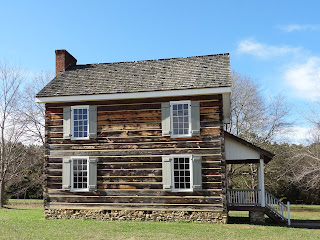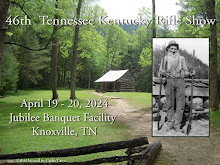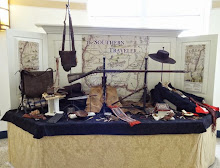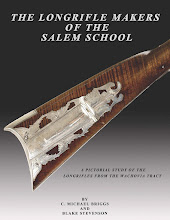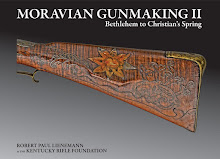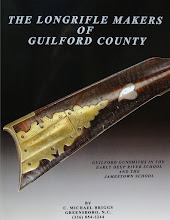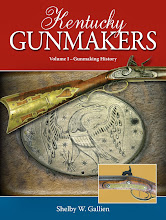Uncle Fed Messer of Haywood County, NC
The following article is adapted from two pieces written by H.E.C. Bryant for the Charlotte Observer, one in 1901, the other in 1907:
Mr. Frederick Messer, of Haywood County, was born in Lincoln, on the South Fork, on August 12th, 1792. This makes him over 109 years old (in 1901). I rode out to see “Uncle Fed” one day last week. He lives with his “girl baby,” Susan, who is past 58 herself. They own a farm home on a small tributary to the Pigeon River.
It was 11:00 when I arrived at Uncle Fed’s home. I left the wagon road about twenty miles out of Waynesville and followed an old, indistinct trail through the woods, over a small stream whose banks were covered with beautiful laurel, holly and hemlock bushes. The distance from the road to the Messer place is about a mile. I did not see any route by which a buggy could approach within several hundred yards of the opening in which the house sits. One must walk or go on a horse.
Uncle Fed’s home is a dilapidated, weather-beaten, double-roomed log cabin. The logs which make its walls still bear the marks of an ax. The roof is made of rough riven boards, the floors of heavy loose planks, and the chimney of rocks gathered from the hillside and streams. One room serves as the kitchen and the other is a bedroom. Eighty odd years have passed over its timbers, and like the man who’s head it has sheltered, it must soon totter and fall.
The doors of the cabin are hung on with hickory thongs. Hinges and staples were unknown to its architect. The chinks between the walls were filled with clay and straw in years earlier but most of them are open now. The wind rushes in and out as if it were tearing through a latticed barn. A half grown boy could crawl through some of the holes. The furniture of the rooms is scanty, the most useful part of it being a carding, spinning, and weaving outfit.
It was to this home that Uncle Fed Messer took his bride eighty four years ago and where he saw her die in 1894, after having become the mother of his nine children and made him a faithful companion for over three-score and ten years.
I rode up to the Messer gate, which was nothing more than a low place in the fence that encloses the yard, and yelled “Hello! I saw no one in sight but from the smoke that rolled out of the chimney, I knew someone was home. At the sound of my voice, a strong looking woman came out of the kitchen and greeted me. Kindness was written across her features. Though a complete stranger, I was welcomed to what she had to offer. “Light stranger and come in,” she said.
“Could you feed my horse, please Mam?”
“Yes, I’ll put a bit of corn right here.” She went right to work and before I could dismount, relieved Topsy of the saddle and took the bit out of his mouth. Then she fetched an apron full of corn.
We shucked the ears and gave them to the horse in a stall trough, cut out of a chunk of wood. I went in to talk to the old man while she returned to the kitchen.
I found Uncle Fed seated on a low split bottom chair on the right-hand side of the fireplace. He was clad in a homespun coat and pants, a soft white cotton shirt, and a heavy pair of brogan shoes and an old slouch hat. His clothes looked like they had been made for a man twice his size and the beard on his face was several days old. Had it not been for his bright gentle eyes, his face would have appeared hard, but the more I studied it the better I liked it. His lame leg hurt him, and at first he was disposed to be downcast. His head was bent over the hearth and he held his face between his hands. Before starting out that morning, I was advised by an acquaintance of the mountaineer to take a bit of whiskey. I did and gave it to him.
He took the bottle and turned it to his mouth, swallowing about a teaspoon full, he smacked his lips and exclaimed, “That’s plum good. Did you bring any t'backer?”
I had to confess that I did not, and promised to send him a piece from the nearest store in the afternoon. After this Uncle Fed brightened up and talked freely. The more he talked, the more enthusiastic he became. The Bible was his favorite theme. It was quite a task to get him to talk about himself. All subjects led to the Bible with him.
“Uncle Fed how old are you?” I asked.
“I was born on the 12th day of August 1792, on the south fork of the Catawba River, in Lincoln County, you can count on that. I remember when President Washington, the man who fought for us in the Revolution, died. I was a little boy,“ he said. (Washington died in 1799, so Messer would have been 7.)
"Who was the first man you voted for President?”
“That was Jeems Monroe. And I had a fight at the election because they wanted to cheat me out of my vote as I wasn’t a free holder. But I walked 12 miles to do it.”
“Uncle Fed, have you drank whiskey and chewed tobacco long?”
“Child, I’s taken a little snip o’ spirits before breakfast for ninety odd years. It takes the flashes off of my stomach. But I never took it any other time for it ain’t good. Took a dram one morning before I started hunting and I seed a deer and I couldn’t shoot it. The whiskey appeared to affect my eyes. I didn’t do that again. I’ve made it a rule all my life to let everything alone that hurts me once. ‘Bout t'backer, I never chewed it till I was grown and then I took a piece to stop a tooth ache. l likes it, but I don’t take much at a time.”
“Uncle Fed they tell me you never button your shirt, what about it?”
“Well, I ain’t had it buttoned but twice in my life. When I got married they made me fasten it at the top and tie a handkerchief around my neck but just as soon as I got foot loose, I tore it off. The other time was the cold Saturday when it was so freezing cold all day if you spit it would freeze before it touched the ground.”
I asked Uncle Fed to tell me some hunting stories.
He thought for a moment, scratching his beard. “Yes sir, I was a great hunter after bear, deer and turkeys. There were several men on Pigeon River that could beat me in a day’s hunt, but I was ahead of them all in a year. I killed 26 deer in one day, 32 turkeys in one, and 4 bear in one. My hunting grounds were right around here, within seven miles of this house. I always used a flintlock rifle, wouldn’t use a shot gun or a percussion-lock rifle. I wanted no caps in mine.
"When I was in my prime I could run down a deer in two hours, I did it in the snow once, I was very strong then and could hold a cripple deer. No man could put my back on the ground, and it took one with a head on him to out do me at log rolling. Now, I feel all the wrenching I got when I was a young man. You ought not strain yourself, because you will suffer for it.
"I was in danger from wild beasts sometimes, I had to run as fast as I could once to get out of the way of a crippled bear. A buck deer came near getting the best of me one day, but I threw him under a pole and cut his throat. Bullets made in Virginny will flatten on a bear’s skull. It takes a pewter bullet to go in.
"The bears were so thick here once I had to blow a wooden bugle to scare them off. They would kill my hogs. I generally found my dead hogs and watched the rough for a bear, and if I got my eye on him first, he was my salad. I killed an old fellow that weighed 200 pounds one morning. There was a four inch cut of fat on his back. I also killed a panther, his tail was three feet long. He was sneaking after me when my old dog struck his trail and put him up a tree. I shot him through the heart. But now the game has gone. I haven’t hunted much in 50 years.”
I asked Uncle Fed if he could read and write.
“Stranger, I can’t read or write, but I can head off half the preachers. I know more about the Bible than anybody in this section. But I’ll bet you don’t know about Sampson’s riddle?”
"I haven’t, what is it?” I asked.
“Out of strength comes sweetness! Sampson pulled the jaw bone off a lion and dropped it in the sun, the bees came out and made honey in the carcass. I can’t read, but when it comes to quoting from the Bible I don’t forget the good measures. Half the educated people forget them and wind up going to Old Scratch!”
At 12:30, I bade the old man good man goodbye and started for my horse. I called by the kitchen and gave the lady twenty five cents for my horse feed. She followed me out and said, “Stranger, you’re not going without your dinner are you?”
“I have a lunch in my pocket,“ I said.
“Well, I don’t like that, for I was preparing a bit of such as we have and it’s ready now. I don’t like for a stranger to come and go away with an empty stomach. Won’t you come back? We’ll divide it with you.”
Seeing that she was in earnest, I gladly turned back. The dinner was on the table within ten minutes and Uncle Fed, Miss Sue and myself were at the table.
I enjoyed every mouthful. We had sweet and Irish potatoes, corn bread, buttermilk, and coffee, a regular mountain menu. I don’t reckon there was ever a regular pound of sugar or flour in the house. The corn bread was made from meal ground at a small water mill on Stevens Creek. Miss Sue had carried a half bushel of corn that day before and had it converted into corn meal. The bread was sweet and wholesome.
Uncle Fed walked to Waynesville last summer. It took him three days to make the trip, but he succeeded. It was then he had his first taste of ice cream. He was at Dr. McFadyen’s for dinner and the day was hot. When had swallowed the last bite, he turned to Miss McFadyen (who gave him the ice cream) and asked “Sissie what kind of cold sass was that you gave me?”
Capt. R.A.L. Hyatt, clerk of the court of Haywood County, had an authentic record of Mr. Messer’s birth. There is no doubt about his age. He would be an attraction worth going to see at an exposition.


